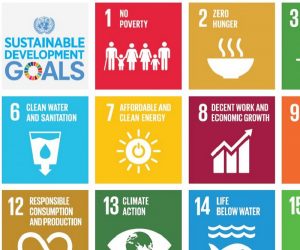Time is almost up for the Millennium Development Goals (MDGs). With the 2015 deadline fast approaching, the United Nations looks to build upon MDG progress by crafting an updated and inclusive post 2015 agenda. Enter the Sustainable Development Goals (or SDGs). The goals will frame the next 15 years of international development by creating a focused and coherent plan of action toward a sustainable future.
In a panel hosted by the Woodrow Wilson International Center for Scholars, Manish Bapna (Executive Vice President and Managing Director at the World Resources Institute) argued a revised set of goals is necessary in achieving universal prosperity. Over the next 15 years, poverty will become more intractable. An ever increasing percentage of nations are becoming environmental vulnerable, many of which already struggle with political and economic instability. These variables muddy the waters in international development considerably, slowing – and in many cases reversing – a nation’s progress by impeding its ability to meet time-bound goals. So how do the Sustainable Development Goals plan on addressing these obstacles? Bapna distilled the differences between the SDGs and MDGs to four key points.
Here’s what you need to know:
1. The Sustainable Development Goals Will Be More Transformative for the Planet
Similar to the MDGs, eradicating extreme poverty lies at the heart of the SDGs. While each of the 17 proposed goals has its own agenda, they collectively address the many facets that complicated global poverty—a distinction that has become increasingly important as political and environmental landscapes continue to change.
2. The Sustainable Development Goals Will Be More Comprehensive in Scope
At their core, the SDGs and MDGs share the same target (eliminating poverty), however, the new SDGs seek to incorporate a more expansive platform than their 2000 counterpart. Most notably, the goals use the concept of sustainability to weave a comprehensive agenda that extends well beyond the social sector. The 17 proposed SDGs incorporate issues of environmental quality (climate change, biodiversity loss, and deforestation) and sustained economic resilience (improving access to sustainable energy sources, building sustainable cities, and promotion of sustained economic growth).
3. The Sustainable Development Goals Will Seek a More Integrative Approach to Development
Many of the objectives of the MDGs were addressed in isolation of one another (maternal health, hunger, gender equality). The SDGs seek to open communication and efforts between the 17 goals in order to present a united and integrated agenda.
4. The Sustainable Development Goals Will Operate on a Universal Scale
The MDGs focused primarily on how the developed world could finance improvements in developing nations. The SDGs, however, speak to poverty in all nations (developed and developing). If the eradicating poverty is truly at the heart of the goals, then there must be a universal and comprehensive push to find an agenda that speaks to all countries and all levels of economic development, to ensure that no one is left behind.
You can read more about the Sustainable Development Goals on the United Nations’ website. The UN had also put together a children’s guide to understanding all 17 proposed goals. Population Education also has several resources that help students understand the challenges facing developing nations. Our annual World of 7 Billion student video contest brings international development to the classroom by asking students to create a public service announcement about one of three global issues.



